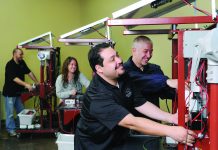Cooling systems of all types are often poorly maintained, incorrectly serviced, or completely ignored. There is certainly room for improvement in this area in industrial applications, and the wind energy industry is no exception. These problems are likely due to issues within cooling systems that occur over a long period of time, enabling poor maintenance because the harm that’s caused is not immediate. However, to help put it in perspective, up to 40 percent of engine failures have been attributed to cooling system problems. Cooling system issues contribute to frustrations within the wind industry, too. Wind farm owners and operators are looking deeper into the increased numbers of insulated gate bipolar transistor (IGBT) failures within their converter’s electrical system. The good news is that there are ways to prevent cooling system-related problems.
Although the cooling systems in wind applications are unique, OEMs specify typical automotive antifreeze/coolants, and rightfully so. The materials and components used for cooling electronics are similar to automotive components, and the systems operate on the same principles. However, there are different needs for the wind energy industry that increase the importance of using a high-quality antifreeze product and implementing a proper maintenance program, particularly because of the costs associated with IGBT failures.
Antifreeze consists of three primary components:
• Water – This is a great heat-transfer fluid, but with it comes some inherent issues such as freezing and corrosion.
• Glycol – This is added to lower the water’s freeze point.
• Additives – These protect against corrosion while providing a number of other functions, including cavitation protection, pH control, lubrication, and anti-scale.
The glycol used in antifreeze is either ethylene glycol (EG) or propylene glycol (PG). The most common is EG, which has a slightly better freeze point and a small advantage in heat transfer when compared at a similar mix ratio. It is also less expensive, making it the popular choice. Because EG is hazardous, a bittering agent is added to antifreeze to help prevent ingestion. PG is the more environmentally friendly choice and is safer to use around children, pets, and wildlife because it is biodegradable and has low toxicity. Due to that benefit, some applications and locations require PG formulations.
Additives Differentiate Antifreeze Performance
There are three categories of additives, and they can all be blended with the two glycols previously mentioned.
• Inorganic salts – The first additive type is found in the old “green” conventional antifreeze product. These products use inorganic salts such as nitrites, phosphates, and silicates to provide protection against corrosion and cavitation, among others. Inorganic salts work by forming a sacrificial layer over all components, and they are fast-acting. However, some of them are harmful to the environment and they deplete quickly, typically only lasting two years or less. Once they are depleted, they can start working against you by causing aluminum corrosion and deposit issues. Inorganic salts can also be incompatible with each other, leading to a dropout substance in the form of an abrasive or slime. For these reasons, automotive OEMs have moved away from that type of antifreeze, and they have banned the use of certain inorganic salts.
• Organic acids – The next additive type is the high-performance choice called organic acids, often referred to as organic acid technology (OAT) or poly organic acid technology (POAT). Organic acids are only used when and where they are needed. This results in much longer-lasting protection. They also do not have the dropout, scale deposit, or compatibility issues that are inherent to inorganic salts. Therefore, this type of antifreeze can be used in a wide variety of applications, even for mixing with other types of antifreeze as top-off.
• Hybrids – The final option available is a combination of the previous two, appropriately called hybrids or hybrid organic acid technology (HOAT). These are a mix of inorganic salts and organic acids, and the way they work is that once the inorganic salts deplete, the organic acids take over. The HOAT provides a blended performance result by alleviating some of the issues with inorganic salts by limiting the quantities and relying on the organic acids to boost the long-term performance. The inorganic salt(s) used in these products vary by application because automotive OEMs have banned various salts from their products due to performance issues. For example, Asian OEMs don’t allow any silicates because they tend to drop out, forming hard particles that can cause seals to leak. They can also lead to scale deposits that insulate surfaces and lead to overheating.
Methods for Changing Antifreeze
There are two ways to accomplish conversion to a different antifreeze type. The ideal way is to use an acid-based flush to ensure any scale deposits that are already present are cleaned out. Otherwise, these can be incorrectly interpreted as a problem with the new antifreeze when routine maintenance is performed. This flush generally requires the following steps:
1. Drain the system’s antifreeze
2. Fill with water and acid-based flush product
3. Run the pump
4. Drain and refill with water
5. Run the pump
6. Drain and fill with new antifreeze
This procedure adds cost and time to the changeover process, so it is not always a realistic option.
Antifreezes are generally compatible; therefore, in some cases, it is also acceptable to simply drain the current antifreeze and replace it with the new one. This can certainly be done when the new antifreeze is a quality OAT product because it is fully compatible with all other antifreezes. If the new antifreeze is a hybrid, be cautious and check which inorganic salts are used to confirm compatibility. A simple drain and refill method does not remove deposits left behind by the previous product. However, quality OAT will ensure that no additional deposits form. This method is recommended for cooling systems that appear to be in good shape. Fully flushing, draining, and refilling the system are recommended for systems with issues such as increased operating temperatures or visible deposits and cloudiness.
Perform Routine Maintenance for Best Results
Antifreeze maintenance is an important consideration because avoidable issues can arise from incorrect practices. The maintenance requirements are slightly different depending on the type of antifreeze used. For hybrids, an extra step must be taken to monitor the inorganic salts so that the fluid can be changed once the salts are depleted. In the over-the-road truck industry, supplemental coolant additives (SCA) are sometimes used to replenish the inorganic salts and extend the drain interval.
OAT simplifies maintenance processes because they do not have the inorganic salts that deplete over time. Otherwise, both antifreeze types should have a maintenance program that includes a simple visual inspection and top-off as required, as well as a pH check. For open systems that may experience water evaporation, an additional glycol ratio check is recommended. If any contamination such as an odd color or cloudiness is noticed, change the antifreeze and inspect the system for the source of the contamination or leaks. If the system is low on fluid, top it off with a premixed product only. If the glycol ratio is off, make an adjustment using only distilled water or a water source that has been tested and approved for cooling systems. Water quality is one of the biggest issues with cooling systems, often contributing to scale deposits and pH issues. An ideal antifreeze mixture will be between 40 and 60 percent glycol to ensure proper freeze protection, heat transfer capability, and that the additive concentration is properly balanced for corrosion protection. The target range for pH is between 7 and 11, depending on the antifreeze type.
Test strips are available to check pH, monitor inorganic salt content, and determine the freeze protection based on the glycol ratio. This can be done by dipping them in the antifreeze and matching the color to a scale. Test strips cost little and provide immediate results, but they are not exact. For more precise results, a full analysis is recommended by pulling a sample and sending it to a lab. A refractometer is the most accurate way to check the glycol ratio in the field.
Although automotive antifreeze/coolants sufficiently protect wind cooling systems, ensuring that equipment stays up and running properly requires routine maintenance. Using a premium OAT antifreeze/coolant is a great first step as it eliminates many of the costly problems associated with the inorganic salts found in both conventional “green” and hybrid antifreeze/coolants and simplifies maintenance processes by lasting longer and eliminating compatibility issues. Although there are many rising issues in the wind industry, we can take a deeper look into other industrial applications and learn from their mistakes to find solutions. Even the simplest products can have the greatest long-term effects. Investing in wind cooling systems now can decrease the issues a wind farm may face down the road.
For more information, go to www.amsoilwind.com.



























